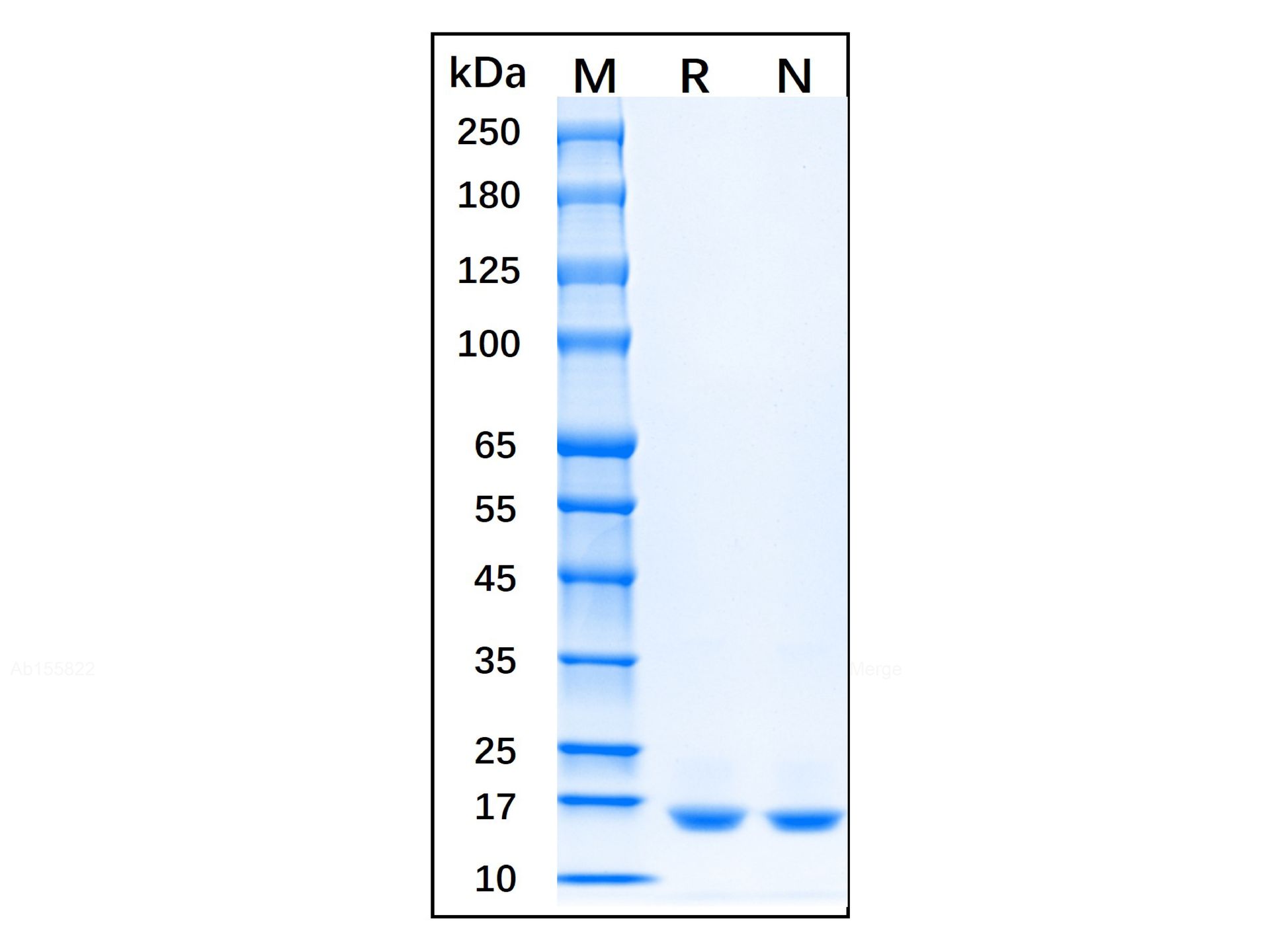Determine the necessary mass, volume, or concentration for preparing a solution.
This is a demo store. No orders will be fulfilled.
| SKU | Size | Availability |
Price | Qty |
|---|---|---|---|---|
|
rp155241-10μg
|
10μg |
Available within 4-8 weeks(?)
Items will be manufactured post-order and can take 4-8 weeks. Thank you for your patience!
|
$169.90
|
|
|
rp155241-50μg
|
50μg |
Available within 4-8 weeks(?)
Items will be manufactured post-order and can take 4-8 weeks. Thank you for your patience!
|
$479.90
|
|
|
rp155241-100μg
|
100μg |
Available within 4-8 weeks(?)
Items will be manufactured post-order and can take 4-8 weeks. Thank you for your patience!
|
$769.90
|
|
|
rp155241-1mg
|
1mg |
Available within 8-12 weeks(?)
Production requires sourcing of materials. We appreciate your patience and understanding.
|
$3,079.90
|
|
Animal Free, >95% (SDS-PAGE), Active, 293F, His tag, 80-235 aa
| Product Name | Recombinant Rat TNF-alpha Protein, >95% (SDS-PAGE), high purity |
|---|---|
| Synonyms | APC1 protein | Cachectin | Cachetin | RATTNF | DIF | TNF | TNF, monocyte-derived | TNFA | TNF-A | TNFalpha | TNF-alpha | TNF-alphacachectin | TNFATNF, macrophage-derived | TNFG1F | TNFSF1A | TNFSF2 | TNFSF2TNF superfamily, member 2 | tumor necrosis factor |
| Grade | ActiBioPure™, Animal Free, Azide Free, Bioactive, Carrier Free, High Performance |
| Product Description |
Background: Tumor necrosis factor alpha (TNF-alpha ), also known as cachectin and TNFSF2, is the prototypic ligand of the TNF superfamily. It is a pleiotropic molecule that plays a central role in inflammation, immune system development, apoptosis, and lipid metabolism. Rat TNF-alpha consisits of a 35 amino acid (aa) cytoplasmic domain, a 21 aa transmembrane segment, and a 179 aa extracellular domain (ECD). Within the ECD, rat TNF-alpha shares 94% aa sequence identity with mouse and 69%-76% with bovine, canine, cotton rat, equine, feline, human, porcine, and rhesus TNF-alpha. TNF-alpha is produced by a wide variety of immune, epithelial, endothelial, and tumor cells. TNF-alpha is assembled intracellularly to form a noncovalently linked homotrimer which is expressed on the cell surface. Cell surface TNF-alpha can induce the lysis of neighboring tumor cells and virus infected cells, and it can generate its own downstream cell signaling following ligation by soluble TNFR I. Shedding of membrane bound TNF-alpha by TACE/ADAM17 releases the bioactive cytokine, a 55 kDa soluble trimer of the TNF-alpha extracellular domain. TNF-alpha binds the ubiquitous 55-60 kDa TNF RI and the hematopoietic cell-restricted 80 kDa TNF RII, both of which are also expressed as homotrimers. Both type I and type II receptors bind TNF-alpha with comparable affinity, although only TNF RI contains a cytoplasmic death domain which triggers the activation of apoptosis. Soluble forms of both types of receptors are released and can neutralize the biological activity of TNF-alpha . Post-translational modifications The soluble form derives from the membrane form by proteolytic processing. The membrane form, but not the soluble form, is phosphorylated on serine residues. Dephosphorylation of the membrane form occurs by binding to soluble TNFRSF1A/TNFR1. O-glycosylated; glycans contain galactose, N-acetylgalactosamine and N-acetylneuraminic acid. |
| Specifications & Purity | ActiBioPure™, Bioactive, Animal Free, Carrier Free, Azide Free, High performance, ≥95%(SDS-PAGE) |
| Purity | >95% (SDS-PAGE) |
| Bioactivity | Measured in a cytotoxicity assay using L‑929 mouse fibroblast cells in the presence of the metabolic inhibitor actinomycin D (Catalog # A113142). The EC50 for this effect is typically <5 pg/mL. |
| Endotoxin Concentration | <0.1 EU/μg |
| Expression System | HEK293 |
| Species | Rat |
| Amino Acids | 80-235 aa |
| Sequence | MLRSSSQNSSDKPVAHVVANHQAEEQLEWLSQRANALLANGMDLKDNQLVVPADGLYLIYSQVLFKGQGCPDYVLLTHTVSRFAISYQEKVSLLSAIKSPCPKDTPEGAELKPWYEPMYLGGVFQLEKGDLLSAEVNLPKYLDITESGQVYFGVIALHHHHHH |
| Protein Tag | C-His |
| N-terminal Sequence | Met |
| Conjugation | Unconjugated |
| Accession # | P16599 |
| Predicted molecular weight | 18 kDa |
| SDS-PAGE | 15 kDa, under reducing conditions; 15 kDa, under non-reducing conditions. |
| Shape | Lyophilized |
|---|---|
| Reconstitution | Always centrifuge tubes before opening. Do not mix by vortex or pipetting. It is recommended to reconstitute to a concentration 0f 0.1-1mg/mL. Dissolve the lyophilized protein in distilled water. Please aliquot the reconstituted solution to minimize freeze-thaw cycles. |
| Storage Temp | Store at -20°C,Avoid repeated freezing and thawing |
| Shipped In | Ice chest + Ice pads |
| Stability And Storage | Store it under sterile conditions at -20℃~ -80℃ for more than 1 year.It is recommended that the protein be aliquoted for optimal storage. Avoid repeated freeze-thaw cycles |

Recombinant Rat TNF- alpha Protein (rp155241) - Protein Bioactivity
Measured in a cytotoxicity assay using L‑929 mouse fibroblast cells in the presence of the metabolic inhibitor actinomycin D (Catalog # A113142). The EC₅₀ for this effect is typically <5 pg/mL.

Recombinant Rat TNF- alpha Protein (rp155241) - SDS-PAGE
3μg/lane of Recombinant Mouse TNF-alpha was resolved with SDS-PAGE under reducing (R) conditions and non-reducing (N) conditions and visualized by Coomassie® Blue staining, showing a single band at 15 kDa.
Find and download the COA for your product by matching the lot number on the packaging.
| Lot Number | Certificate Type | Date | Item |
|---|---|---|---|
| Certificate of Analysis | Jul 03, 2023 | rp155241 | |
| Certificate of Analysis | Jul 03, 2023 | rp155241 | |
| Certificate of Analysis | Jul 03, 2023 | rp155241 |

Starting at $106.90